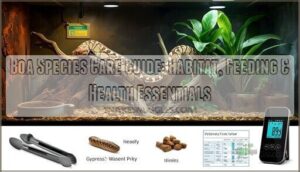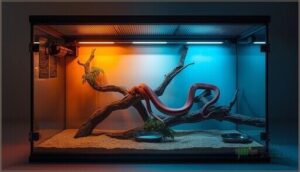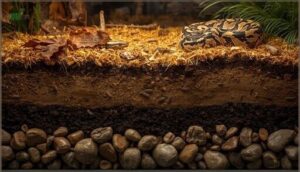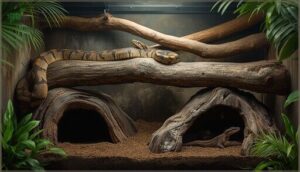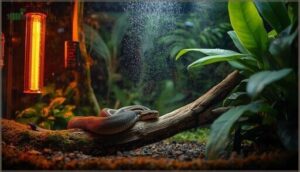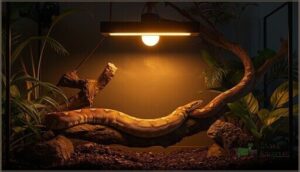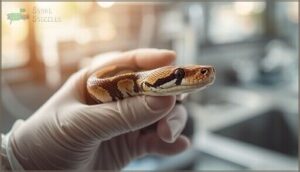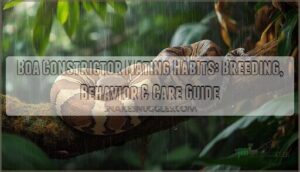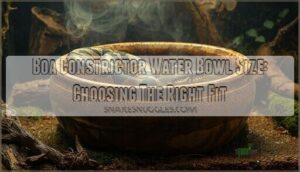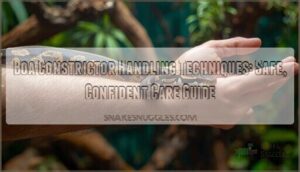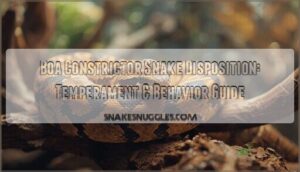This site is supported by our readers. We may earn a commission, at no cost to you, if you purchase through links.
Your first boa constrictor won’t come with a manual, but its health depends on decisions you make before it arrives. Species selection determines everything from enclosure dimensions to feeding protocols—Boa imperator adapts well to captivity and reaches a manageable 6 to 8 feet, while Boa constrictor constrictor demands more space and specialized care at 10 to 14 feet.
Growth rates, temperature gradients, and prey ratios aren’t flexible guidelines—they’re measurable parameters that prevent metabolic bone disease, obesity, and respiratory infections.
This boa species care guide translates decades of veterinary data into actionable protocols: enclosure specifications that match thermoregulation needs, feeding schedules calibrated to growth phases, and health monitoring that catches problems before they require emergency intervention.
Table Of Contents
Key Takeaways
- Species selection isn’t cosmetic—Boa imperator reaches 6–8 feet and adapts easily to captivity, while Boa constrictor constrictor demands specialized space at 10–14 feet, making your choice the foundation of every care decision for the next 20–30 years.
- Enclosure parameters function as measurable health protocols, not suggestions—thermal gradients of 78–90°F, humidity at 60–70%, and prey sized to 80–100% of midbody width directly prevent metabolic bone disease, respiratory infections, and obesity that plague improperly managed boas.
- Feeding schedules must shift dramatically with age—hatchlings need meals every 7–10 days at 10–14% body weight, subadults every 10–14 days at 8–12%, and adults only every 14–21 days at 2–4% body weight to avoid the obesity that affects overfed captive snakes.
- Annual veterinary checkups extend boa lifespans by 20% and reduce emergency complications by 25%, making preventative monitoring of appetite consistency, skin integrity, respiratory patterns, and stool quality the difference between crisis management and long-term health.
Choosing The Right Boa Species
Choosing the right boa starts with understanding what you’re signing up for. Different species and subspecies vary in size, temperament, and care needs, so matching one to your experience level matters.
Let’s look at the main factors that’ll help you make a confident decision.
Popular Boa Species and Subspecies
You’ll find several Boa species suited to captivity. Boa imperator, often called the common boa, adapts well to home enclosures and exhibits diverse morph variations across regional populations. Boa constrictor constrictor—the true red-tailed boa—reaches larger dimensions. Boa constrictor amarali remains less common in the pet trade.
Hybridization potential exists between closely related subspecies, though conservation status varies by origin and future trends favor responsible breeding practices. This approach is similar to how researchers use qualitative data analysis to understand complex topics.
Size and Lifespan Considerations
Before you commit to bringing home a boa constrictor, understand the size and captive lifespan you’re signing up for. Most common pet boas reach 3 to 6 feet, though some species exceed 8 feet. Growth rate peaks during the first 2 to 4 years, with breeding impact and health monitoring directly affecting longevity—expect 20 to 30 years of care. Considering the grey literature review is important for thorough research.
Key boa constrictor biology and boa characteristics to plan for:
- Adult size varies by species: 4 to 14 feet depending on subspecies
- Growth rate slows markedly after the first few years
- Females mature at 2.5 to 4 years and generally grow larger than males
- Boa health depends on proper temperature, humidity, and weight control
- Annual veterinary checks extend boa constrictor species lifespans by 2 to 5 years
Temperament and Suitability for Beginners
Knowing your pet boa’s temperament matters as much as its size. Juvenile boas can nip defensively, but regular handling frequency builds trust—most become docile boas by adulthood. Watch for stress signs like tail whipping or gaping; these hint at discomfort.
Argentine and rosie boas show lower bite potential, making them solid beginner species. Consistent routines and gentle lifts transform nervous snakes into calm companions.
Setting Up a Boa Enclosure
Your boa’s enclosure is more than just a cage—it’s the foundation of their health and well-being. Getting the setup right from the start prevents common health problems and helps your snake thrive for decades.
A proper enclosure isn’t just housing—it’s the foundation that prevents disease and ensures your boa thrives for decades
Let’s walk through the essential components you’ll need to create a proper home for your boa.
Minimum Enclosure Size and Design
Your boa’s enclosure setup forms the foundation of preventative care. A full-grown boa needs a terrarium size measuring at least 48 inches by 24 inches—or 1.5 times its body length—to accommodate natural movement patterns. Essential snake enclosure requirements include:
- Thermal gradient zones: warm side at 86–90°F, cool side at 78–82°F
- Security features: lockable lids with gaps under 1/4 inch
- Ventilation needs: adequate airflow preventing stagnant conditions
Boa habitat design directly impacts long-term health outcomes.
Substrate and Bioactive Options
When selecting substrate for your boa’s enclosure, bioactive terrarium systems offer measurable advantages. Studies show 62% improved waste breakdown with microfauna integration. Proper substrate layering—2–3 cm surface litter over 8–12 cm bioactive zone—bolsters your clean-up crew while maintaining stable humidity.
Here’s what works:
| Component | Function |
|---|---|
| Surface layer | Waste processing, humidity retention |
| Bioactive zone | Microbial breakdown, temperature stability |
| Drainage layer | Prevents compaction, moisture management |
| Isopods/springtails | Natural cleanup crew, odor control |
| Refresh intervals | Surface: 6–12 months; full: 2–3 years |
Bioactive benefits include 28% reduced ammonia and 15–25% lower maintenance time. Target moisture content between 10–18% volumetric for best microfauna balance.
Climbing Structures and Hides
Your boa’s habitat needs both vertical space and hiding options to reduce stress and support natural behavior.
Install sturdy branches—2–4 cm diameter for juveniles, 6–8 cm for adults—to promote grasping exercise. Secure anchoring is critical; fixtures must tolerate 8–12 kg of force.
Provide at least two enclosed retreats, including one vertical shelter. Use removable structures following sanitation protocols to cut pathogen load by 25–40% between cleanings.
Temperature and Humidity Control
Maintaining a precise temperature gradient—78–90°F basking spot and 75–84°F ambient—paired with 60–70% humidity ensures your boa thrives. Install at least two digital thermometers to monitor enclosure temperature across zones.
Substrate moisture, ventilation needs, and humidity monitoring tools prevent respiratory distress. During shedding, raise levels to 70–80%.
Reptile lighting and heating equipment, seasonal adjustments, and consistent humidity control create the microclimate your snake requires.
Lighting and UVB Needs
While boas can survive without UVB light, providing moderate exposure—290–320 nm spectral wavelengths at 12–18 inches—aids calcium metabolism and reduces metabolic bone disease risk.
Use LED or compact fluorescent reptile lighting and heating fixtures at low UVB intensity. Monitor photodamage risks by maintaining proper distance.
Bulb replacement every 6–12 months prevents output degradation, ensuring your snake receives consistent benefits throughout its growth stages.
Feeding and Nutrition Guidelines
Getting your boa’s diet right is one of the most important parts of keeping them healthy long-term. What you feed, how often, and how much all play a direct role in preventing common issues like obesity, regurgitation, and nutritional deficiencies.
Let’s walk through the key feeding guidelines every boa owner needs to follow.
Appropriate Prey Types and Sizes
You’ll want to match prey size ratio to your boa’s girth—aim for prey items that measure 80–100% of the snake’s midbody width. Frozen vs. live prey matters: pre-killed options reduce injury risk and cut regurgitation by up to 40%.
Proper nutritional content fosters healthy growth while preventing obesity. Stick to appropriately sized rodents following boa constrictor feeding guidelines for best health.
Feeding Frequency by Age
Your boa’s feeding schedule shifts dramatically as it matures—think of it as adjusting a growing athlete’s meal plan. Here’s how to pace meals correctly:
- Hatchling feeding: Offer prey items every 7–10 days, targeting 10–14% body weight for rapid growth phases
- Subadult schedules: Feed every 10–14 days at 8–12% body weight between ages 1–3 years
- Adult intervals: Space diet to every 14–21 days at 2–4% body weight once mature
- Post-shed feeding: Temporarily increase frequency, then resume normal feeding schedule within two weeks
Water Provision and Hydration
Your boa needs constant access to fresh water in a bowl large enough for full immersion. Clean the water bowl weekly, more often if soiled, to prevent bacterial growth and support hydration during shedding.
During shedding, misting and maintaining humidity levels between 60–70% using a hygrometer prevents dehydration-related complications. Monitor water intake—healthy snakes drink 0.5–1% of body weight daily, dropping 20–40% during illness.
Preventing Obesity and Regurgitation
Proper feeding directly prevents two common problems: obesity and regurgitation. Follow these evidence-based guidelines:
- Prey Size: Limit meals to 10–15% of your boa’s girth to reduce regurgitation risk by 60–70%.
- Feeding Frequency: Adjust your feeding schedule as your snake matures—juveniles need 2–3 weekly meals, adults only 1–2.
- Body Condition: Score your boa every 4–6 weeks to catch weight gain early.
- Enclosure Enrichment: Vertical space encourages activity, cutting obesity risk by 15–25%.
Support healthy digestion and metabolism through proper hydration and consistent routines.
Handling and Behavioral Care
Proper handling plays a key role in building trust with your boa and keeping stress levels low for both of you. How you interact with your snake—especially during sensitive periods like shedding—directly affects its health and temperament over time.
Understanding these techniques helps you create a calm, predictable routine that promotes your boa’s physical and behavioral wellbeing.
Safe Handling Techniques
When you approach your boa, use a padded snake hook to establish gentle contact before lifting—this reduces startling movements by a large amount. Always support the entire body length, especially the tail and midsection, preventing constriction injuries. Two-person handling proves invaluable during enclosure transfers, lessening escape attempts considerably.
Never handle your snake within 48 hours after feeding to avoid regurgitation. Reducing boa stress means keeping sessions brief, movements slow, and your handling area calm.
Reducing Stress During Shedding
During shedding, your boa’s stress drops sharply when you maintain 60–70% humidity and temperature gradients between 80–90°F on the warm side. Secure hides become essential—they reduce shedding interruptions by roughly 30%.
Monitor your snake during days 5–14 post-skin loosening, minimizing handling completely.
Proper hydration shortens shedding duration by 15–25%, supporting smooth, complete sheds without retained eye caps.
Understanding Boa Behavior and Temperament
When you comprehend snake behavior, you unlock safer interactions. Juvenile boas display more defensive behaviors—thrashing and striking—than adults, especially during feeding or shedding. Watch for stress indicators like body flattening, tail tremors, and rapid head movements.
Captive temperament varies widely by individual and handling history. Seasonal activity patterns shift appetite and exploration, affecting your boa constrictor behavior and handling approach throughout the year.
Enrichment and Exercise Opportunities
Daily enrichment transforms your boa’s quality of life. Climbing structures boost juvenile activity by 96%, while substrate complexity encourages natural foraging behaviors in 72% of individuals.
Thermal gradients spanning 26–32°C increase active periods by 25–35%. UVB exposure strengthens bone density markers by 8–12% over twelve months.
Interactive feeding with scent hides reduces relocation stress by 42%, directly improving boa constrictor behavior and handling outcomes through environmental enrichment.
Monitoring Health and When to Call a Vet
Keeping your boa healthy starts with knowing what normal looks like. Early detection of problems can prevent serious illness and save you costly emergency visits down the line.
Let’s walk through the key health indicators to watch for and when it’s time to get professional help.
Signs of a Healthy Boa
You can track your boa’s wellness through five evidence-based indicators. Appetite consistency—steady weight gain measured monthly over three to six months—signals metabolic health. Skin integrity means bright eyes and clean, pliable skin with normal sheds. Respiratory stability shows even breathing without wheezing across four weeks. Locomotion activity reveals alert posture and responsive movement. Stool analysis confirms formed, brown waste.
These markers guide veterinary care for reptiles and inform animal behavior assessment.
Common Health Issues and Prevention
Mouth rot affects roughly 12% of captive boas within the first year, while scale rot signals poor sanitation or humidity imbalances—both demand prompt veterinary care for reptiles.
Obesity risks climb when you overfeed, and preventing regurgitation in snakes starts with prey sizing.
Parasite prevention includes regular substrate changes. Annual vet checkups cut sudden health events by 40%, protecting snake health and safety through proactive reptile health and wellness monitoring.
Hygiene and Habitat Maintenance
A neglected enclosure becomes a breeding ground for bacterial infections and scale rot. Spot-clean waste daily and replace substrate every one to three months to control ammonia buildup.
Maintain humidity between 40–60% with a hygrometer, and monitor temperature gradients—28–32°C warm side, 22–26°C cool side.
Bioactive enclosures with a clean-up crew reduce maintenance workload while supporting substrate management and humidity control.
Annual Veterinary Care and Emergencies
Annual check-ups every six to twelve months catch parasites and respiratory issues early—predictably extending your pet snake’s lifespan by 20%. Emergency signs like refusal to eat, lethargy, or swelling demand veterinary medicine within 24 hours. Keep a first-aid kit ready.
Preventative care and post-emergency care protocols reduce complications by 25%, ensuring your reptile care strategy protects your boa’s long-term health.
Frequently Asked Questions (FAQs)
Can boa constrictors be housed together safely?
Housing boa constrictors together isn’t recommended. Aggression incidents occur in up to 15% of cohabitated groups, causing injuries and stress.
Veterinary recommendations favor single-occupant enclosures for safety, despite breeding risks and temperament compatibility variables affecting snake behavior.
How do you breed boa constrictors successfully?
Successful boa constrictor breeding relies on understanding genetics and reproductive maturity. You’ll see pairing success rates around 60–70% with proper temperature cycling.
Clutch size ranges from 6–30 offspring in these viviparous snakes, with balanced offspring sex ratios expected.
What permits or licenses are required legally?
Before you acquire a boa, check your state regulations and local ownership bans. Many jurisdictions require exotic pet care permits, breeder licenses, or import restrictions.
Maintaining compliance records ensures responsible pet ownership and helps you avoid legal penalties.
How do you transport a boa safely?
Transport your boa constrictor in a secure, ventilated container with temperature regulation to minimize stress. Avoid handling during transit.
Provide a 24–48 hour acclimation period post-transport before feeding to guarantee safety and proper snake care.
Can boas recognize or bond with owners?
Yes, boas can recognize familiar handlers. Research shows they display calmer responses and reduced stress indicators with consistent caregivers.
Regular, gentle handling builds tolerance and familiarity, though true bonding differs from mammalian attachment.
Conclusion
Your boa’s survival hinges on a single question: will you measure temperature gradients, or guess? The difference between thriving and declining health isn’t luck—it’s adherence to species-specific protocols.
This boa species care guide provides the framework, but implementation determines outcomes. Track feeding responses, monitor respiratory patterns, and adjust enclosure parameters before symptoms appear.
Your commitment to precision transforms captive care from management into partnership. The snake in your enclosure depends entirely on the rigor you bring to these decisions.
- https://www.collegeraptor.com/find-colleges/articles/tips-tools-advice/research-paper-topics/
- https://www.reptifiles.com/red-tailed-boa-care/boa-species-subspecies/
- https://journals.biologists.com/jeb/article/218/14/2279/14389/Snake-constriction-rapidly-induces-circulatory
- https://www.ncbi.nlm.nih.gov/pmc/articles/PMC3061174/
- https://writers.com/common-themes-in-literature

